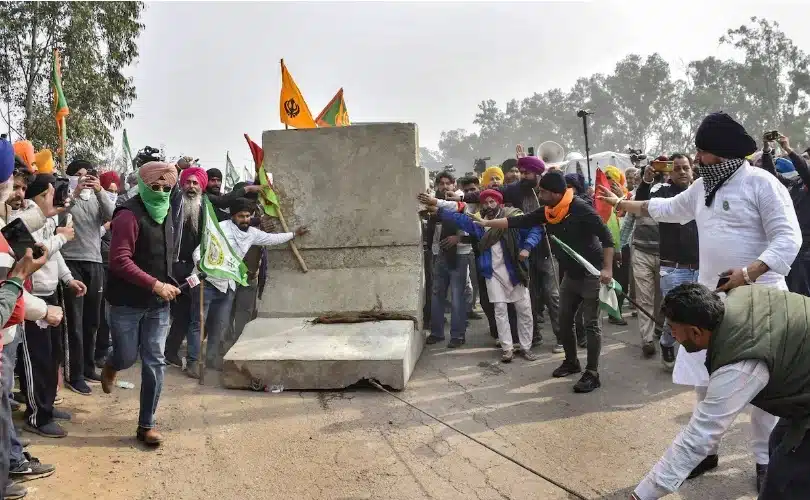What’s in today’s article?
- Why in news?
- Minimum Support Price (MSP) Regime in India
- 2022 Committee
- Term of reference of the committee
Why in news?
- A major demand of the farmers protesting in Delhi is for the enactment of a law to guarantee minimum support prices (MSP) for all crops, as per the formula recommended by the Dr M S Swaminathan Commission.
- This comes at a time when a committee appointed by the central government in July 2022 continues to deliberate on ways to make MSP more effective and transparent.
Minimum Support Price (MSP) Regime in India
- Background:
- The Food-Grain Enquiry Committee, established by the Nehru administration in 1957, was the first attempt to address the agricultural earning issue.
- However, it turned out to be insignificant.
- Then, in 1964, Lal Bahadur Shastri formed the Food Grain Price Committee (under LK Jha), to push for a MSP regime.
- Despite the fact that the report was quickly accepted by the Shastri government, the first MSP announcement was made in 1967.
- Thus, the MSP regime came into existence as a policy decision and the government set up the Agricultural Prices Commission for fixing MSP for crops.
- The commission was renamed as the CACP in 1985.
- The Food-Grain Enquiry Committee, established by the Nehru administration in 1957, was the first attempt to address the agricultural earning issue.
- About MSP:
- MSP is a form of market intervention (a policy decision not enforceable by law) by the Government to insure agricultural producers against any sharp fall in farm prices during bumper production years.
- These are announced by the Cabinet Committee on Economic Affairs (Chaired by the Prime Minister of India).
- The recommendations of the Commission for Agricultural Costs and Prices (CACP) at the beginning of the sowing season for certain crops forms the basis of these announcements.
- The CACP considers the following factors when recommending MSPs –
- A commodity’s demand and supply;
- Its cost of production;
- Market price trends (both domestic and international);
- Inter-crop price parity;
- The terms of trade between agriculture and non-agriculture (the ratio of farm input and farm output prices);
- A minimum of 50% as a margin over cost of production; and
- The likely implications of an MSP on consumers of that product.
- Objectives
- MSPs are a guarantee price for farmer’s produce from the Government to prevent the farmers from distress sales and to procure food grains for public distribution.
- E.g., if the market price for a commodity falls below the specified minimum price due to bumper production and a market glut, government agencies will buy the entire quantity supplied by farmers at the announced minimum price.
- Crops covered:
- Government announces MSPs for 22 mandated crops and fair and remunerative price (FRP) for sugarcane (total 23).
- Crops covered by MSPs include:
- 7 types of cereals (paddy, wheat, maize, bajra, jowar, ragi and barley),
- 5 types of pulses (chana, arhar/tur, urad, moong and masur),
- 7 oilseeds (rapeseed-mustard, groundnut, soyabean, sunflower, sesamum, safflower, nigerseed),
- 4 commercial crops (cotton, sugarcane, copra, raw jute).
2022 Committee
- Background
- This panel was constituted seven months after farmers who had gathered at Delhi’s border called off their year-long protest, after the Prime Minister announced the repeal of the farm laws.
- The committee’s subject matter has three points: MSP, natural farming, and crop diversification.
- However, the terms of reference do not include a legal guarantee for MSP.
- About
- The committee was notified by the Union Ministry of Agriculture and Farmers’ Welfare in July 2022.
- The committee, which has 26 members, is headed by Sanjay Agrawal, a former agriculture secretary.
Term of reference of the committee
- To promote Zero budget natural farming (ZBNF).
- ZBNF guides farmers toward sustainable farming practices, which helps to retain soil fertility, ensure chemical-free agriculture, and ensure low production costs (zero cost), thereby increasing farmers’ income.
- To provide suggestions on 5 points regarding natural farming including –
- Suggestions for programmes and schemes for value chain development, protocol validation and research for future needs.
- Support for area expansion under the Indian Natural Farming System by publicity and through involvement and contribution of farmer organizations.
- To change crop patterns keeping in mind the changing needs of the country.
- To recommend measures to strengthen the Agricultural Marketing System in response to the country’s changing needs.
- This is to ensure higher value to farmers through remunerative prices for their produce by capitalizing on domestic and export opportunities.
- To provide suggestions on 4 points related to crop diversification including –
- Mapping of existing cropping patterns of agro-ecological zones of producer and consumer states;
- Strategy for diversification policy to change the cropping pattern according to the changing needs of the country;
- Arrangement for agricultural diversification and system to ensure remunerative prices for the sale of new crops;
- Review and suggestion on micro irrigation scheme.
- To make MSP more effective and transparent.
- It will also make recommendations to give CACP more autonomy as well as measures to make it more scientific.
Q1) What is Commission for Agricultural Costs and Prices (CACP)?
The Commission for Agricultural Costs and Prices (CACP) is a decentralized agency of the Government of India that advises the government on the price policy of major agricultural commodities.
Q2) What was M S Swaminathan?
Mankombu Sambasivan Swaminathan (1925 – 2023) was an Indian agronomist, agricultural scientist, plant geneticist, administrator, and humanitarian. He was a global leader of the green revolution, a program that involves planting high-yield varieties of wheat and rice seedlings.
Source: As Congress backs farmers’ MSP demand, what has the govt committee set up in 2022 done so far? | Vikaspedia| India Today
Last updated on June, 2025
→ UPSC Notification 2025 was released on 22nd January 2025.
→ UPSC Prelims Result 2025 is out now for the CSE held on 25 May 2025.
→ UPSC Prelims Question Paper 2025 and Unofficial Prelims Answer Key 2025 are available now.
→ UPSC Calendar 2026 is released on 15th May, 2025.
→ The UPSC Vacancy 2025 were released 1129, out of which 979 were for UPSC CSE and remaining 150 are for UPSC IFoS.
→ UPSC Mains 2025 will be conducted on 22nd August 2025.
→ UPSC Prelims 2026 will be conducted on 24th May, 2026 & UPSC Mains 2026 will be conducted on 21st August 2026.
→ The UPSC Selection Process is of 3 stages-Prelims, Mains and Interview.
→ UPSC Result 2024 is released with latest UPSC Marksheet 2024. Check Now!
→ UPSC Toppers List 2024 is released now. Shakti Dubey is UPSC AIR 1 2024 Topper.
→ Also check Best IAS Coaching in Delhi
























